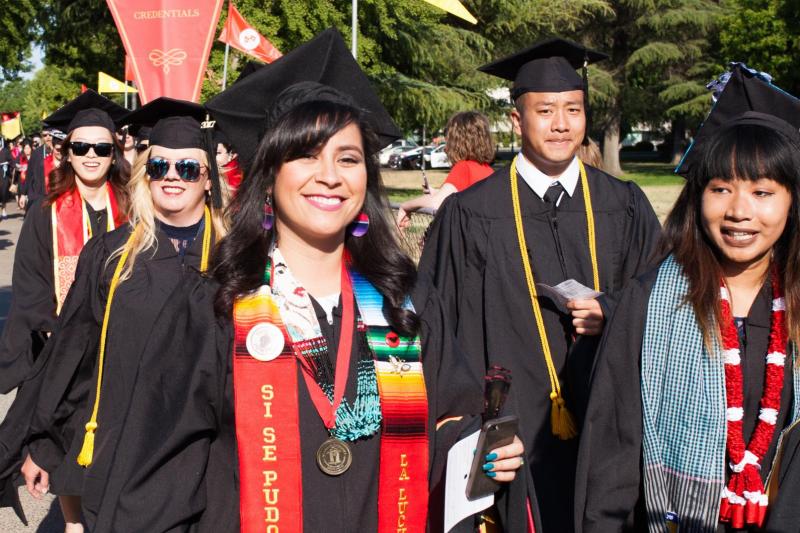
Provost Kimberly Greer and members of the University Strategic Planning Council laid out the final draft’s essential parts in a presentation at Snider Recital Hall.
The plan includes five overarching principles covering themes rather than University divisions, a deliberate effort to have all groups take ownership of all parts of the plan, Greer said. “We had a lot of conversation about being bold in how we crafted the plan and not having it be silo-ed. We wanted it to be a plan where people could find inspiration for themselves and their departments in many places,” she said.
1. Be a student-ready university
This simple statement has many facets, but at its core puts student success at the top of the list, said Suzanne Espinoza, vice president for student affairs.
It includes supports for academic success, raising graduation rates and greater enrollment in graduate studies, she said, “but also building a sense of belonging and helping students to grow, building co-curricular programs that help them find who they are, using University resources to help them along their path.”
2. Facilitate transformational learning experiences driven by faculty success
The best teachers, this goal affirms, are life-learners, and the best education environments nurture faculty as well as student exploration and collaboration. In its strategies, it strives to better align spending and personnel decisions with University priorities of scholarship, diversity and equity.
“This reflects our strong commitment to student success — which includes graduation, but is not solely that — and doing good things in our community, really being leaders and doing what we can to foster the kind of education we aspire to provide,” said David Colnic, chair of the Department of Political Science and Public Administration.
3. Boldly pursue innovation and creativity
“If you read strategic goals carefully, what you find is there is one goal that picks up on the essence of the entire plan. I think this is the one that sets us apart,” said Gitanjali Kaul, vice president for strategic planning, enrollment management and innovation.
“It comes from a good place,” she said, “from the fact that we are comfortable with how our programs are growing, comfortable with how things are run on campus, and this is the time to sit back and think about a visionary future. How can we sustain high outcomes over a long period of time?”
This goal envisions innovation by creating inter-disciplinary degrees focused on solving regional problems and exploring online baccalaureate programs or hybrid classes. It suggests establishing a think tank — bringing together the University, public entities and industry to develop entrepreneurial activities. Practical objectives include upgrading classroom technology, increasing classroom space and harnessing tech advances to streamline procedures.
4. Hone administrative efficacy through thoughtful stewardship of resources
All of the objectives above will take a commitment of time and money. But finding dollar savings through greater efficiencies is only one aspect of the fourth goal, said Darrell Haydon, vice president for business and finance.
“It’s really about taking a broad look at the University to identify all the different ways we could make changes, improve processes and invest dollars in a way that is thoughtful, and supports our underlying purpose of supporting students,” he said. “At the end of the day, we need to have a campus that is welcoming, with spaces that students want to come to.”
5. Forge and strengthen bonds with our communities, rooted in a shared future
This goal speaks to regional collaboration and a sense of being part of a wider world, said Stuart Sims, chair of the Department of Music and co-chair of the University Strategic Planning Council. “We recognize that a rising tide lifts all boats,” he said. “The idea of collaboration with public and private sectors opens the door to a whole new kind of activity for this institution.”
Seeking grants and partnering with businesses can spur and sustain applied research by faculty and students to solve regional problems, Sims said. It opens the door to giving credit for hands-on collaborations. “This document outlines aspirations as much as it addresses ways to realize the potential that this offers,” Sims said, stressing that the Strategic Plan will be a living document.
The strategies listed include robust development of the Stanislaus State Stockton Center, with educational and business partnerships in the Stockton community and a greater range of student support services and faculty in residence. Being a cultural hub, networking through local civic groups and continuing to work with school districts to improve educational outcomes are all encompassed in Goal 5.
“We’re going to act on this. We’re going to find different ways to make it real and we want the strategies to adapt and adjust,” Sims said. “There’s a lot that we haven’t thought of, and it only will be thought of when we’ve been at it a few months.”